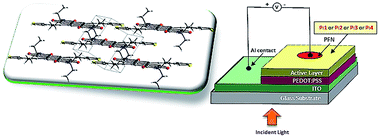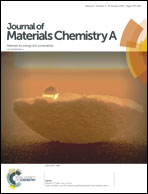Modulation of the power conversion efficiency of organic solar cells via architectural variation of a promising non-fullerene acceptor†
Abstract
Thiophene-containing molecular materials are recognised as efficient substrates in organic photovoltaics. Herein, we have demonstrated the effect of substitution patterns of thiophenes on the electron accepting ability of perylene bisimide derivatives, which in turn dictates the photovoltaic performance. The thiophene units were integrated through α- or β-positions on the 1- or 1,7-bay positions of perylene-bisimide through alkyne spacers in order to modulate the electronic properties of PBI. The target molecules are structurally robust as per electrochemical studies and exhibited broad absorption in the visible region. Better light harvesting ability and favourable LUMO energy levels render these dyads and triads suitable as electron acceptors in organic solar cells. Bulk heterojunction solar cells were constructed from thienyl–PBI (1–4) as acceptors and a polymer P as a donor. α-Linked 1 and 3 showed a PCE of 5.72% and 6.94% with a remarkable energy loss of 0.55 eV and 0.58 eV, respectively whereas, β-linked 2 and 4 showed an overall PCE of 4.93% and 6.06% with an energy loss of 0.52 eV and 0.54 eV, respectively.



 Please wait while we load your content...
Please wait while we load your content...